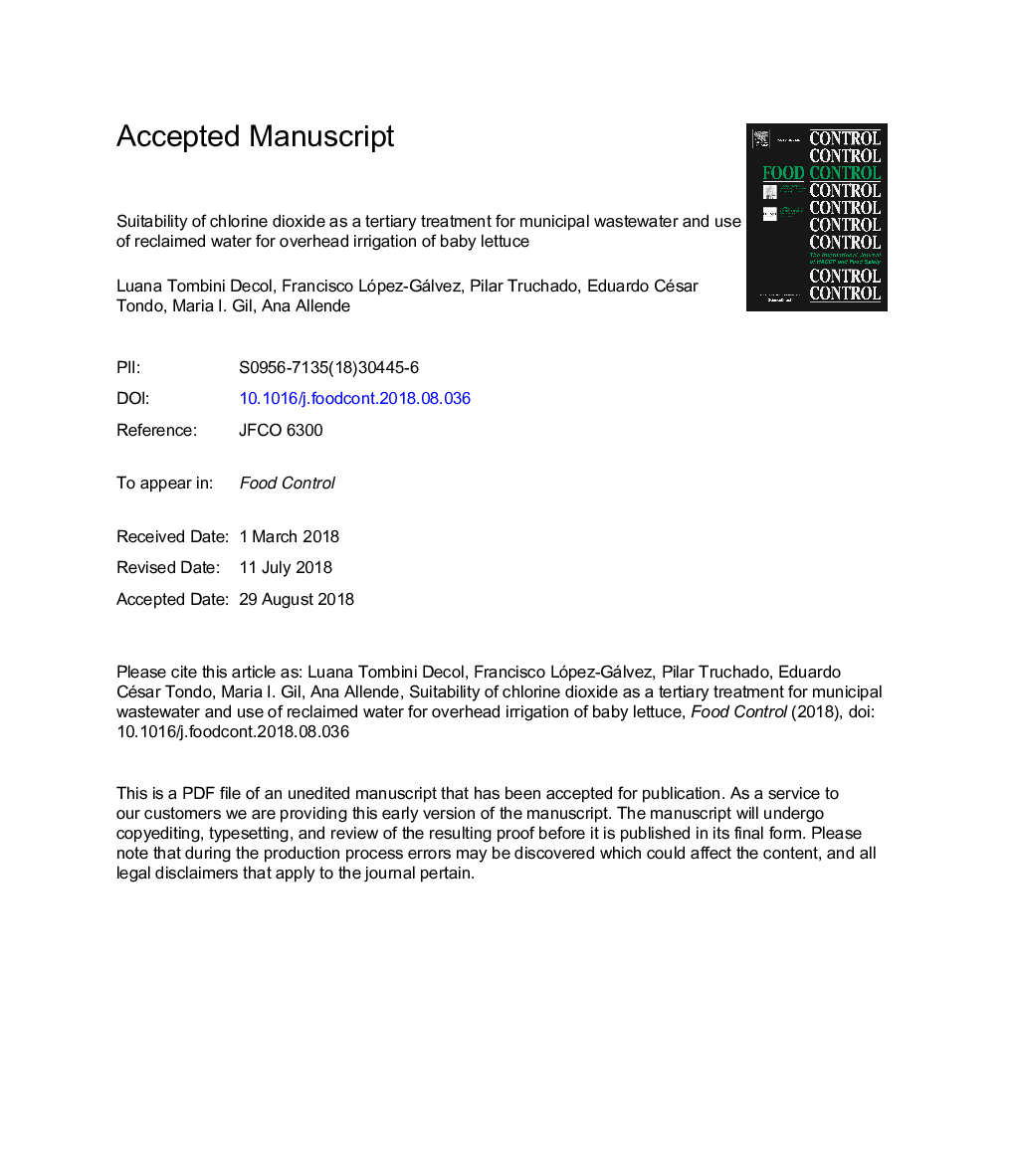| کد مقاله | کد نشریه | سال انتشار | مقاله انگلیسی | نسخه تمام متن |
|---|---|---|---|---|
| 11030337 | 1646320 | 2019 | 40 صفحه PDF | دانلود رایگان |
عنوان انگلیسی مقاله ISI
Suitability of chlorine dioxide as a tertiary treatment for municipal wastewater and use of reclaimed water for overhead irrigation of baby lettuce
ترجمه فارسی عنوان
مناسب بودن دی اکسید کلر به عنوان یک درمان عالی برای فاضلاب شهری و استفاده از آب بازیافت شده برای آبیاری سرازیری کاهو
دانلود مقاله + سفارش ترجمه
دانلود مقاله ISI انگلیسی
رایگان برای ایرانیان
کلمات کلیدی
تولید تازه، میوه ها و سبزیجات، آب کشاورزی، ضد عفونی آب، پاتوژن مواد غذایی، ضدعفونی کننده های جانبی، خطر شیمیایی،
موضوعات مرتبط
علوم زیستی و بیوفناوری
علوم کشاورزی و بیولوژیک
دانش تغذیه
چکیده انگلیسی
Reclaimed wastewater used for agricultural irrigation should meet specific microbiological standards in order to prevent microbial contamination of the irrigated produce. The objective of this study was to evaluate the suitability of chlorine dioxide (ClO2) for the disinfection of secondary-treated municipal wastewater and its subsequent use for overhead irrigation in greenhouse production of baby lettuce. The impact of reclaimed water tertiary-treated with ClO2 on E. coli concentration, the presence of pathogenic bacteria, and the occurrence of chlorates as disinfection by-products was evaluated in water and in baby lettuce. E. coli was quantified using both conventional plating methods and a quantitative real time PCR (qPCR) method with propidium monoazide (PMA) pre-treatment to differentiate between viable and non-viable bacteria. Population density of cultivable E. coli was significantly lower (pâ¯<â¯0.05) in reclaimed water, tertiary-treated using ClO2 (ClO2W), when compared with secondary-treated municipal wastewater (SW). However, no significant differences in viable but non-cultivable (VBNC) E. coli loads were observed between treatments when quantifying using the PMA-qPCR method. These results could indicate that ClO2 treatment of water did not kill the bacteria but it induced bacteria to enter a VBNC state. The proportion of samples positive for the presence of pathogenic bacteria was lower in ClO2W (1/8) compared with SW (7/8). Significantly lower E. coli counts (pâ¯<â¯0.05) were detected in plants irrigated with ClO2W compared with those irrigated with SW. Relationship between higher E. coli counts and the presence of pathogens was observed when lettuce samples were analyzed by PMA-qPCR (Mann-Whitney U Test, pâ¯<â¯0.05). Baby lettuce irrigated with ClO2W showed a significantly higher concentration of chlorates than lettuce irrigated with SW. The quantification of viable bacteria using molecular methods suggests that the efficacy of ClO2 could be overestimated when conventional plating quantification methods are used. Additionally, the accumulation of chlorates in the tissue should be considered as it represents an adverse effect of this disinfection treatment.
ناشر
Database: Elsevier - ScienceDirect (ساینس دایرکت)
Journal: Food Control - Volume 96, February 2019, Pages 186-193
Journal: Food Control - Volume 96, February 2019, Pages 186-193
نویسندگان
Luana Tombini Decol, Francisco López-Gálvez, Pilar Truchado, Eduardo César Tondo, Maria I. Gil, Ana Allende,
